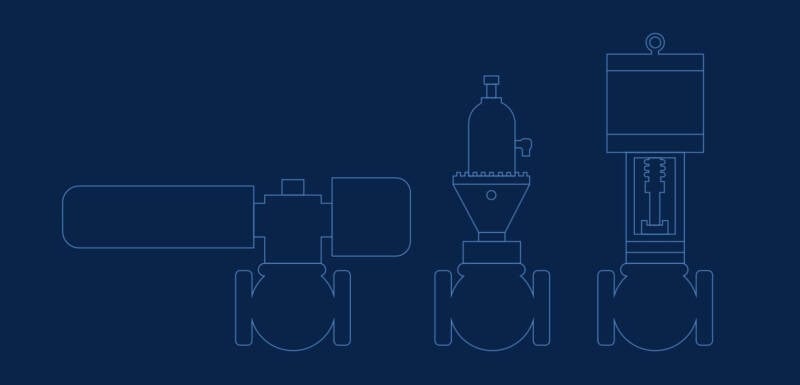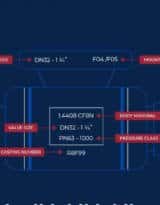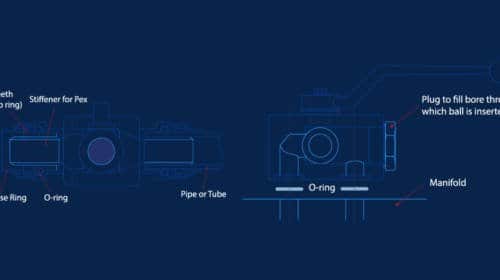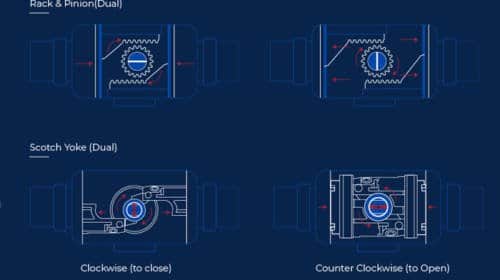Linear Valve Actuators: When They Should Be Used

A linear valve actuator is a mechanical device that transforms rotational movement into linear movement in a push/pull motion, thereby enabling valve closure components to follow a straight path to attain the desired position. Linear motions can include moving up, down, forward or backward.
Often used in industrial processes when the system requires frequent flow changes, linear actuation methods are commonly employed in a wide range of industries, such as automotive, food, chemical and energy processing. Linear valve actuators are used to operate linear valves such as globe valves or gate valves. These valves are utilized for many industrial and commercial applications, including:
- Food and Beverage
- Chemical mixing
- Oil and Gas
- Wastewater
- Commercial buildings
Read on to learn more about these important devices, the various types of linear actuation, the benefits of using a linear valve actuator and more.
What is a Linear Valve Actuator?
To understand what a linear valve actuator is, it is essential to understand the type of valves they control. A linear valve often operates as a control valve with a stem that moves valve closure components along a straight path (up, down, forward or backward) to achieve the desired position. However, not all linear valves operate as control valves. For example, a gate valve is a type of linear valve that should only be used for on/off service.
Linear valve actuators provide an automated valve solution that can be particularly helpful in certain applications where manually positioning the valve is dangerous or impractical.
The four main types of linear valve actuators are:
- Pneumatic
- Electric
- Hydraulic
- Electro-Hydraulic
When working with a linear valve actuator, the actuator motion is powered by an electric, hydraulic (fluid) or pneumatic (gas) source. In some cases, a linear valve actuator may be powered by both electric and fluid power, this is referred to as an electro-hydraulic actuator.
How Does a Linear Actuator Work?
Linear valve actuators work by converting energy from a power source into movement that results in the opening or closing of a valve. Depending on the type of linear actuation method, different devices may utilize various components, including pistons, cylinders, gears, spindles, rods and fluid reservoirs.
Depending on the type of linear actuator, it may use pressurized air, fluid, or an electrical motor to cycle the valve to the desired position.
Pneumatic Valve Actuator
Today, most pneumatic valve actuators use a rack and pinion design. These actuators are made up of two or three key parts: a piston, a pinion and sometimes mechanical springs. These components are housed within a cylindrical chamber and work together to generate linear movement by converting compressed air into energy. The energy produced can then power the movement of the actuator.
This type of linear valve actuator is most commonly required in scenarios where both speed and accuracy are prioritized. Linear pneumatic actuators can work to abruptly move or control the valve and, when equipped with the appropriate control mechanisms, can precisely calibrate the valve’s position as required by the application.
Advantages:
- High speed
- Low upfront cost
- Long-lasting
Disadvantages:
- Bulky
- Requires a pneumatic air supply
Pneumatic valve actuators are well suited for high-cycle processes, where a failsafe is necessary in the event of power loss. They are commonly used in the following applications:
- Oil & gas
- Automotive
- Pharmaceutical
- Food & beverage
- Power processing
- Chemical admixtures & treatment
Hydraulic Actuator
While a pneumatic linear valve actuator uses compressed air to generate energy for movement, a hydraulic linear valve actuator uses oil- or water-based fluid.
Hydraulic actuators are composed of cylinders and a piston, which use incompressible fluids — liquids that maintain a consistent density throughout the flow process — to create unbalanced pressure on the piston. This, in turn, causes pressurized fluid to enter the device’s chamber and press against the piston, thus achieving linear movement, i.e. the opening or closing of the valve. Once the pressure on the fluid is released, the piston returns to its original position.
Advantages:
- High speed
- Accurate
- Simple to operate and repair
Disadvantages:
- Vulnerable to leaks, resulting in lower efficiency and sanitation concerns
- High-maintenance system that requires frequent monitoring
Hydraulic valve actuators are ideal for processes that require a steady flow of pressure, with few speed or motion changes. They are also a great option for applications in harsher environments, such as welding, pressing and clamping.
Electric Actuator
Just as the name suggests, electric linear valve actuators are powered by electricity in the form of an AC or DC motor. This electric motor consists of a gear train and a lead screw or belt drive mechanism that causes the valve’s stem to move. Linear electric actuators are available in a variety of sizes and voltages.
Advantages:
- Simple to install
- Easy to program
- Extremely precise position control
- No pumps, hoses or tanks
- Less expensive
Disadvantages:
- Slow acting
- Difficult to repair
Electric linear valve actuators are best suited for applications that do not require high-speed cycles, as well as processes that emphasize sanitation. Examples include material handling, solar panel operation, food and beverage manufacturing, medical device manufacturing and equipment cutting.
Electro-Hydraulic Actuator
The fourth type of linear valve actuation method is the electro-hydraulic actuator, which combines features of electric and hydraulic actuators. Electro-hydraulic actuators are able to function without a discrete hydraulic pump which simplifies the overall system.
Electro-hydraulic actuators consist of an electric motor, which turns gears in a clockwise motion to create a pressurized liquid flow. When the target pressure is reached, the valve actuator opens to extract liquid from the reservoir and control the movement of the fluid to extend the rod. To reverse this process, the actuator moves in a counterclockwise motion that delivers the liquid back to the reservoir. This process essentially functions as a hydraulic pump built directly into the actuator.
Advantages:
- Easy to install
- High force output
- Features fail-safe capabilities
- Offers remote diagnostics
- Fast
- Accurate position control
Disadvantages:
- Most expensive linear valve actuator type
- Difficult to repair
- High power consumption
- Frequent maintenance required
- The hydraulic components required are more complex than pneumatic and require much more investment upfront
Electro-hydraulic linear valve actuators are useful in situations where an emergency failsafe is needed to halt flow when power is lost. This mechanism can help protect the equipment, as well as the surrounding environment and personnel.
Electric vs Pneumatic Actuators
Electric and pneumatic linear actuators are the two most commonly used actuators for linear valves. The key difference between these linear valve actuators is the type of energy they utilize to actuate the valve.
For operations that require and emphasize cycle speed, a pneumatic linear valve actuator is the best option. There are many advantages and disadvantages to consider when choosing between electric and pneumatic. The chart below highlights some of the basic pros and cons of each.
| Electric Linear Valve Actuator | Pneumatic Linear Valve Actuator | |
| Maintenance | Very low | High |
| Energy Consumption | Low | High |
| Cost | Lower cost overall | Lower cost upfront |
| Noise Level | Low | High |
| Motion Control Capability | High | Low |
| Accuracy | High | Medium |
| Cycle Speed | Low | Fast |
| Force | Generally lower than pneumatic | Generally higher than electric |
| Durability | High | Very high |
Components and Design of a Linear Actuator
There are four key components considered in the design of a linear actuator: power source, power converter, controller and mechanical load.
The device’s power source varies depending on the actuation method and falls under three categories: electricity, air or fluid.
The power converter within a linear actuator transfers power from the energy source to the actuator via the unit’s controller, which enables the input of various measurements, such as quantities and setpoints. The controller acts to maintain appropriate system functions.
Linear actuator mechanical loads exist in two forms:
- Static, which occurs when the actuator is stopped
- Dynamic, which occurs when the actuator is moving
Although the various types of linear valve actuators possess different capabilities, advantages and disadvantages, they all work to convert energy into motion.
Benefits of Linear Valve Actuators
Several important benefits come with using valve actuators for certain applications. When using a linear valve, linear valve actuators provide many of the same benefits as other valve actuator types. Though each type of linear valve actuation method differs slightly, most offer the following advantages:
Operator safety
Since linear valve actuators enable machines to work autonomously without manual intervention, the risk to operators is minimal. These actuators are generally safer than alternative methods of converting energy.
Affordable cost
Most linear valve actuators are on the more affordable end of the cost spectrum. Although upfront costs may be higher than other methods — rotary actuators, for example — the long-term expense can be more affordable. However, this depends on a wide variety of application details.
Acceptable noise level
With the exception of pneumatic actuators, most linear valve actuation methods operate quietly or even without noise altogether. While noise levels depend on the way the actuator is being employed, as well as the quality of the device’s construction materials, they average less than 55 dB.
Linear Actuation Method FAQs
Q: What type of linear valve actuators are best suited for processes that emphasize speed?
A: Pneumatic linear actuators are the best option for applications that require speed.
Q: Which linear valve actuator should I use if I need precise control over modulation and valve position?
A: modular electric linear actuator is the best choice when precision is needed.
Q: What is the difference between a hydraulic valve actuator and an electro-hydraulic actuator, and which is better?
A: Electro-hydraulic linear actuators eliminate the need for a discrete pump and can reduce the complexity of the overall system.
Q: What are the pros and cons of linear actuators vs rotary actuators?
A: The choice between rotary and linear actuators depends on the type of valve you have selected for your application. Rotary valves tend to offer faster cycle times, whereas linear valves tend to offer more precise control and are generally less prone to water hammer due to the slower cycle time.
Q: What types of valves can be used with linear actuators?
A: Linear valves such as globe valves or gate valves can be used with linear actuators.
How to Read Ball Valve Markings [Downloadable Cheat Sheet]
This resource provides a helpful “cheat sheet” for identifying and interpreting ball valve markings at a glance.




